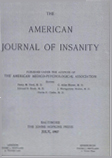A FIVE TO TEN YEAR FOLLOW-UP STUDY OF 641 SCHIZOPHRENIC CASES
Abstract
1. Of 641 clinically diagnosed cases of schizophrenia, admitted to the Rhode Island State Hospital for Mental Diseases, between 1929 and 1934, and followed for 5 to 10 years, 27.5 per cent were found to be at present in the community, 53.5 per cent were in mental hosiptals, 13.9 per cent were dead and for 5.1 per cent no adequate follow-up information could be obtained.
2. Adequate follow-up data were available for 608 patients; of these 6.6 per cent were much improved, 15.3 per cent improved, 63.5 per cent unimproved and 14.6 per cent dead.
3. Classification on the basis of diagnostic subtype showed that 35 per cent of the simple, 16.4 per cent of the hebephrenic, 30 per cent of the catatonic, 16 per cent of the paranoid and 36.4 per cent of the "other" group were much improved or improved. Many of the cases in the latter category were of the so-called schizoaffective type.
4. The age of onset of psychotic symptoms had little bearing on the outcome, except that those cases having an onset at the age of 45 or later tended to do less well than those having the onset at a younger age.
5. Of those cases with symptoms of less than 6 months duration prior to hospitalization 34.5 per cent were much improved or improved. For those with symptoms of 6 to 11 months, 29.4 were benefited; for those with symptoms of 12 to 23 months 27.8 per cent benefited; while for those with symptoms of 2 years or longer only 16 per cent were benefited.
6. 75.3 per cent of the patients requiring a hospital stay of 6 months or less were improved while only 4.2 per cent of those remaining in the hospital for 5 years or longer improved. Patients requiring hospital care for more than 2 years showed little tendency to improve.
7. Disregarding the dead and untraced cases, 259 or approximately 50 per cent of 519 patients left the hospital at some time or other for more than one month; of these 129 have continued to remain outside the hospital while 47 returned temporarily and 83 permanently. The much improved and improved groups show a higher percentage of cases remaining out of the hospital continuously and a smaller percentage of returns than the unimproved group.
8. Pulmonary tuberculosis was the most common cause of death, being responsible for 43 or 48.2 per cent of 89 deaths. 10 (11.2 per cent) cases committed suicide.
Access content
To read the fulltext, please use one of the options below to sign in or purchase access.- Personal login
- Institutional Login
- Sign in via OpenAthens
- Register for access
-
Please login/register if you wish to pair your device and check access availability.
Not a subscriber?
PsychiatryOnline subscription options offer access to the DSM-5 library, books, journals, CME, and patient resources. This all-in-one virtual library provides psychiatrists and mental health professionals with key resources for diagnosis, treatment, research, and professional development.
Need more help? PsychiatryOnline Customer Service may be reached by emailing [email protected] or by calling 800-368-5777 (in the U.S.) or 703-907-7322 (outside the U.S.).



